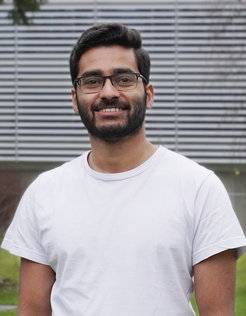Dr. Hemanth Somarajan Pillai is Awarded the Prestigious Alexander-von-Humboldt Fellowship for Postdoctoral Researchers
The Fritz Haber Institute is thrilled to announce that Dr. Hemanth Somarajan Pillai has secured a prestigious Alexander-von-Humboldt fellowship to continue his postdoctoral work in the group of Dr. Vanessa Jane Bukas. With his expertise in Density Functional Theory and Microkinetic Modelling, Dr. Pillai will contribute to advance the Theory Department´s understanding of electrocatalysts and their selectivity.

After receiving his high-school degree from the Bonn International School, Dr. Pillai joined the Syracuse University in the USA for a 4-year Degree in Chemical Engineering, where he had the opportunity to spend a semester in Prof. Jesse Bond´s laboratory. Here, he gained strong foundations in chemical and physical science, paving the way for his further interest in the field of catalysis.
Dr. Pillai joined the group of Dr. Vanessa Jane Bukas in the Theory Department at the beginning of 2023, after receiving his PhD Degree from Virginia Tech, USA. During his PhD, he worked in the group of Dr. Hongliang Xin within the Department of Chemical Engineering, using Machine Learning to accelerate catalytic materials discovery for sustainable nitrogen transformation. Moreover, he closely collaborated with experimentalist to validate active electrocatalyst candidates for electrochemical oxidation of ammonia and reduction of nitrate. Both the reactions have a pivotal role in environmental and public health. On one side, oxidation of ammonia generates electrons in ammonia-based fuel cells, converting chemical energy stored in the ammonia fuel into electrical energy. On the other hand, electrochemical reduction of nitrate helps mitigating environmental pollution and protecting water quality, by effectively removing or converting nitrate ions in wastewater.
A considerable number of publications stem from Dr. Pillai's PhD project, many of which were published in highly relevant journals for the field, such as Nature Catalysis, Energy & Environmental Science, Nature Communications, and others. Among these, Dr. Pillai contributed to providing a mechanistic picture of nitrate reduction to ammonia, supporting the community in overcoming limitations of current catalysts. Furthermore, he developed an accurate yet inherently interpretable Machine Learning model capable of extracting physical insights into chemical bonding.
In 2019, he was awarded the NSF non-academic research internship award, which allowed him to spend 4 months at the SLAC National Laboratory operated by Stanford University, further strengthening his passion and motivation to pursue a career in academia. In addition to his scientific efforts, Dr. Pillai is actively engaged in the community, representing his PostDoc colleagues within the Department and Institute, advocating for their rights, promoting academic exchange and opportunities for mentorship.
In the next two years at the Institute, Dr. Pillai will explore the connection between electrocatalyst morphology and selectivity through mass transport phenomena, by using computational methods such as Density Functional Theory (DFT), Microkinetic Modeling, and Continuum Modeling. Selective product control in a variety of reactions, such as carbon dioxide and nitrate electro-reduction, is essential to developing future sustainable energy technologies. Therefore, it is fundamental to focus on understanding how changes in catalysts’ morphology can influence the reaction path that is being followed and, hence, the product that is being formed.
Dr. Pillai says: “I have been here for about a year now and during this time I have had the opportunity to learn a lot of new and interesting things, as well as for meeting great people. I am therefore excited for the next two years to come, where I hope this trend will continue.”
The Fritz- Haber-Institut and especially the Theory Department celebrates Dr. Pillai´s award and eagerly anticipates both his contributions and his continued presence on the team for the next two years.
Alexander-von-Humboldt significance and figures
The Alexander-von-Humboldt Foundation is known for its commitment to promoting international scientific cooperation. Established in 1860, the foundation has been fundamental in fostering connections between researchers across the World and supporting academic exchange.
In 2023, the Foundation preserved an interdisciplinary network of over 30.000 Humboldtians across 140 countries in the World. Among those, 61 have been awarded a Nobel Prize.
Between 2018 and 2022, a total of 4,690 and 1,790 research stays were sponsored in Germany at universities and at non-university research institutions, respectively. In the last Humboldt Rankings from 2023, Max Planck institutes head the list of non-university research institutions, with the Fritz Haber Institute in Berlin leading. The Fritz Haber Institute hosted a total of 68 researchers in the years from 2016 to 2022. This means that the FHI hosts the most Humboldt researchers in Berlin behind the major universities (FU, HU, TU).












